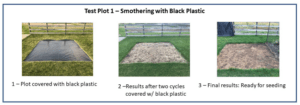Greetings from Monarch Research. In this blog episode, we’d like to share our progress on five sample test plots at the Monarch Research Station showing the various methods to successfully establish native habitat in a 10X10 area (mini-prairie). Each of these examples provide a good approach to this 100SF habitat that can easily be established in your own yards. As you may be aware if you have not already, you can register to be a Pollinator Zone on our website at monarchresearch.org. With that registration and a commitment to prepare your site along with documenting photographs, we will provide a rich seed mix for planting at no charge up to 400SF. We can provide an additional 400SF in exchange for a donation of $10. In addition, detailed planting instructions are available on this website as well under Pollinator Zones.
Special thanks need to go out to Mike Martin and his team for their hard work in preparing these test options. While each 10X10 area on its own is a pretty easy task, doing all five and photographing progress has been a big job.
Here is a description and some comments for each test plot with a few accompanying photos showing process and progress:
All Test Plots – Pictures of properly prepared Pollinator Zones (Initial Steps for Site Preparation)
Test Plot 1 – Smothering with black plastic, leaving in place for 4 weeks, removing for 2 weeks. Planting late fall with seed mix

Comments:
This is the standard organic approach to planting a small space from seed. It is very low cost and works well. By taking the plastic off several times during the summer, it gives any remaining weed seeds a chance to germinate and then to be killed once the plastic goes back on. This and test plot #5 are very similar. For a full description, feel free to watch the PZ101 Webinar from this last June on our website
Test Plot 2 – Removal of sod manually or with a sod cutter; Planting with larger potted plants

Comments: We did this one to show you what to expect if you decide to clear the area of preexisting turf grass. This is hard work but if you have some experience and a strong back, it can work. However, there will be weeds no matter what you do. But, using potted natives (available at more and more nurseries these days) you can minimize weeds with mulch between plants and some diligence. This approach is expensive, but you get pretty much immediate results. Plan to spend $10 or so per pot. This plot has a total of 25 plants in the 10X10 area)
Test Plot 3 – Solarization using clear plastic for a full growing season. Planted the following Spring with seed mix (Spring 2021)

Comments: This variation uses clear plastic and it is left on for the entire summer. This is another inexpensive method that does not disturb the soil which is a good thing, and pretty much burns everything up during the hot summer months. You can either plant in late Fall or the following Spring based on your preference. This test plot will be Spring planted using the same mix
Test Plot 4 – Repeated tillage of site every 3 weeks for a full growing season. Planted with plugs 8 weeks before freeze

Comments: This test was done to show what rototilling would produce and then planting the plot with a plug kit from one of the seed vendors. This test plot was first sprayed with glyphosate (once) and then tilled every few weeks. You could also just spray two or three times rather than till. Native plugs are certainly more expensive than a package of seeds, but they should do well and are more cost effective than the larger plants used in plot #2 above. The photograph shows 25 plants in this area. Over time, those will spread and will likely need to be split and transplanted as some of these plants get quite large. Tilling in general while effective and controlling weeds, is highly disruptive to the soil and to the organisms that live in the soil, but we wanted to show it as it will work and many people till their gardens.
Test Plot 5. Smothering with black basic for a full growing season. Planted late fall with seed mix

Comments: This approach is the same as #1 above but the plastic is simply stapled down and left all summer. We wanted to see if there was any difference in the following spring/summer in terms of growth – both native plants and non-native weeds.
Summary
So, there you have it. We will be doing the Fall planting soon and showing you how that works, and we’ll be back to you in the Spring with an update! Good planting and all the best from Monarch Research!!
Jim Hoffman and Mike Martin


